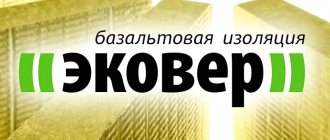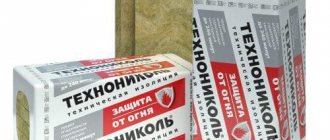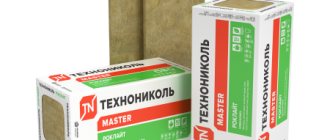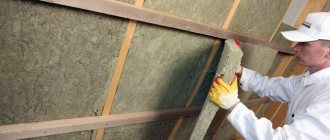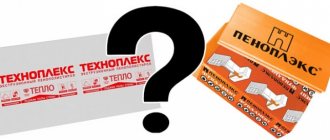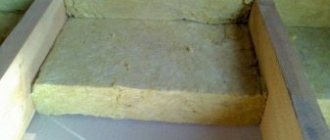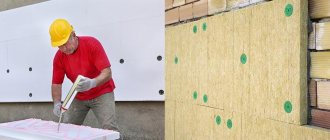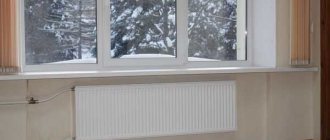They say, “the shortest road is the one you know.” By choosing time-tested materials, for example, TechnoNikol Rocklight insulation, we save time and effort. On the other hand, before making a decision, you need to check all the facts, find out the technical characteristics, and find out reviews from those who have already used this insulation. This article covers all of the above.
Definition : TechnoNikol Rocklight are semi-rigid slabs made of stone (basalt wool).
Peculiarities
The definition implies the features or advantages of this insulation, namely:
- Fire safety. The insulation is NG class, which means it does not contribute to the spread of fire. For many consumers, this factor is decisive when choosing stone wool insulation. The latter is preferred over polystyrene foam, which releases toxic substances when burned.
- High vapor permeability. The thermos effect is only good for tea in winter. But the room must, to a reasonable extent, not only retain, but also REMOVE heat or moisture. Otherwise, over time, a living room or office would turn into a steam room.
- Convenience and simplicity when insulating. Mineral wool Rocklight provides for installation without wet processes. And this type of installation is faster, more convenient and simpler.
- Low thermal conductivity. For the central regions of Russia, 50 mm insulation is recommended, although there are much denser options.
Top 8 manufacturers
The construction advantages of a mineral wool product depend on the size and thickness of the fibers, the quality and safety of the binders and chemical components in the composition.
Buy products only from trusted and well-known brands, and check the originality :
| Manufacturer | Description |
| Danish brand with production in Russia. Thanks to this nuance, the products are inexpensive - from 100 rubles. per m². The brand is distinguished by the highest fire safety, sound absorption, durability without deformation, as well as the lowest thermal conductivity values | |
| an expensive brand, but high-quality and effective - for 1 m² you will have to pay from 380 rubles. The product retains heat well, absorbs noise, and does not collect dust. This product rarely has counterfeits on the market. | |
| expensive, but very effective insulation from stone and fiberglass components, produced separately for each type of coating: for roofs, walls, floors, acoustic partitions. The composition does not contain toxic phenol-formaldehyde resins, so the product is actively used in private residential premises. Price – from 250 rub. per m² | |
| The manufacturer offers glass wool and stone wool in different forms. It is strong, elastic, which is important - it almost does not prick. Price per m² - from 120 rub. | |
| the company produces basalt mineral wool in the form of dense rectangular slabs. The product line includes insulation for floor insulation, internal partitions, external facades, metal roofs, and there is also a product with enhanced sound insulation properties. Price per m² - from 120 rubles. | |
| mineral glass wool, using acrylic as a binding ingredient. The structure is very rigid and elastic, retains heat well and blocks sounds from the street. Average price – from 110 rub. per m² | |
| an inexpensive product with excellent characteristics of heat resistance, sound insulation, environmental friendliness and low hygroscopicity. Basalt wool from a Belarusian manufacturer is produced in the form of rolls and layers, holds its shape well, is hard and elastic. Price – from 80 rub. per m² | |
| another budget material, but not inferior in efficiency. Not very dense, so it crumbles a little during installation. Price – from 80 rub. per m² |
On construction sites, the cost is indicated immediately for a roll or package of insulation, and its quantity in m³ is written next to it.
Product in the form of plates
There are many brands on the Russian market that differ in price and area of use. Before purchasing, you need to study in detail the features of each brand, its properties, advantages and disadvantages. You should choose mineral wool insulation taking into account various factors: type of room, fiber size, intended purpose, coverage area, etc.
We propose to study in detail this material, its varieties, application and selection criteria. We will analyze in detail the myths that are associated with the use of mineral wool and find out how justified they are. We will compile a rating of top brands, with prices and brief characteristics.
How Rocklight is born
Basalt wool is a mineral in origin. To put it simply, it is a stone. This very material is heated to a huge temperature: more than 2000 degrees and the rock begins to melt, forming fibers, which are then separated from each other.
Then the fibers are dried and ground using special machines. As a result of all processes, cotton wool is formed, which is 98% air.
Rocklite insulation is 98% air
Now the non-flammable properties of this material become more clear: the stone does not burn. But it is worth saying that different compositions are used to glue these same fibers. And some, especially scrupulous researchers, believe that such mixtures contain the notorious formaldehyde. When burning, naturally, these substances will enter the atmosphere.
Types of substance
Roof insulation
It is incorrect to consider stone, basalt, slag and glass wool as synonyms for mineral wool. Firstly, the stone and basalt subspecies are essentially the same thing. This is insulation that is made from rocks, including basalt.
Secondly, all of the above subspecies are substances of mineral origin, which means they are varieties of mineral wool. Thus, the composition of the material may be very different, but its functions and structure are identical.
The product is produced using the same technology:
- The base material is poured into the oven and melted to a homogeneous consistency
- Next, the composition is blown through a fine grate - this is how fibers are formed
- Hot threads settle in a special chamber, where they will be made into a single fabric
- To bind the fibers together, they are enveloped in a binder mixture (phenol-formaldehyde resin)
- The processed mass is pressed and left to cool
- To increase strength and resistance to environmental influences, the wool is coated with a polymer alloy and subjected to heat treatment again
Basalt (stone)
Stone variety
Basaltic (stone) Igneous rocks, mainly basalt, are taken as the basis. Thanks to the properties of this mineral, insulation can be made in different densities and hardnesses.
Advantages of stone wool:
- It is the most flexible and pliable, so it is easier and faster to install
- Solid types are considered the most durable and are used in places with high loads
- Soft types are easy to distribute in hard to reach areas
- It has the highest threshold of tolerance to high temperatures - up to 800°C
Glass wool
Thermal insulation of pipelines
Glass wool It is made from recycled glass, broken glass, and waste from the glass industry. Soda, sand, lime and chemical reagents must be added to the base.
Material Features:
- Glass wool is less durable than stone wool, but it costs less
- Has a yellow tint
- The surface of the canvas is prickly, so you need to work with gloves. The size of glass fibers is very small, but it is capable of making micro cuts and creating a chemical burn to the skin
- The substance is rarely used in residential premises, more often in industry, for insulation of communication engineering systems
A significant advantage of glass wool is that it is practically odorless. This is very important for wet rooms, such as baths or saunas.
Slag
Blast furnace slag melt product
Slag The most rarely used type of mineral wool in our time, produced from the remains of alloys in a blast furnace. It is the cheapest in price, but its characteristics are the lowest. The material is soft and does not retain its shape well, so it is produced only in rolls.
It is afraid of humidity and quickly collapses under its influence. Has the shortest shelf life.
Where is the material used?
TechnoNicole Rocklight, as already mentioned, is a semi-rigid mineral slab. It can be used in:
- Vertical;
- Horizontal;
- Sloping surfaces.
BUT! No external load. According to the TechnoNikol company website, the material has a compression rate of 30%, and the density varies between 30 to 40 kg per m3. This density will be quite enough to withstand the vertical load under its own weight when the insulation is used in frame structures. But, it will not be enough with additional load. Therefore, this thermal insulation is not used in wet facades, but only in curtain walls.
If we give more specific examples of the use of Rocklight, we can highlight:
- Sound and heat insulation of interior partitions;
- Insulation of the facade under siding and other hanging systems;
- Creating an attic microclimate.
For example, in the video below, representatives of TechnoNikol recommend Rocklight as insulation for the attic.
Basalt wool, names
Insulation materials made from cotton wool are produced in ten main directions:
- AXI,
- BASALT,
- TECHNOACUSTIC,
- ROCKLIGHT,
- TECHNOBLOCK,
- TECHNOVENT,
- TECHNOLIGHT,
- TECHNORUF,
- TECHNOFAS,
- TECHNOFLOOR.
Of course, each direction represents a material for a specific application. Some types are more or less universal insulation materials. For example, Technofas, as the name suggests, is a slab for facade insulation from TechnoNikol.
Stone wool is produced at factories in Cherkassy, Rostov-on-Don, Zainsk and Chelyabinsk. [flat_ab id=”33″]
Main characteristics
The table below shows all the main technical characteristics of the insulation for those who like to know all the subtleties.
TechnoNicole Rocklight characteristics
| Indicator name | Unit measurements | ROCKLIGHT |
| Compressibility, no more | % | 30 |
| Flammability | degree | NG |
| Thermal conductivity | λ 10 | W/m·S |
| λ 25 | 0.039 | |
| λ A | 0.04 | |
| λ B | 0.041 | |
| Vapor permeability, not less | mg/(m h Pa) | 0.3 |
| Humidity by weight, no more | % | 0.5 |
| Water absorption by volume, no more | % | 2 |
| Content of organic substances, no more | % | 2.5 |
| Density | kg/m 3 | 30-40 |
You can notice that the density of Rocklight is slightly lower than that of Technoblock Standard. And the compressibility is completely inferior by 3 times or more. But, this may not be a disadvantage in itself; rather, it all depends on the approach and application.
Is mineral wool dangerous for health?
This is what phenol-formaldehyde resin looks like when frozen
Many have heard the common myth that mineral wool is harmful to health due to the phenol-formaldehyde resin it contains. In large quantities, this substance becomes carcinogenic. On this basis, many studies and risk assessments for humans have been carried out.
As a result, the following conclusions were made:
- The resin content in the insulation is 4 times less than the maximum permissible norm
- After heat treatment, the resins acquire a solid form. They do not evaporate into the air, which means they are not dangerous
- All patented mineral wool brands have test certificates
- People encounter phenol-formaldehyde compounds every day. For example, a billiard ball is made entirely of this resin. It is added to the chipboard from which furniture is made, to carpets, and plastic dishes.
Buy insulation only from trusted suppliers who can provide test reports and hygiene certificates.
Minuses
Although in general, TechnoNikol products have proven themselves in the market, as you know, there are no ideal things. This means that Rocklight also has its “dark” sides.
Firstly, users note that mice still eat it. And if they don’t eat, they definitely gnaw. Therefore, like polystyrene foam, insulation requires the construction of a dense frame through which unexpected inhabitants of your home cannot reach it.
Secondly, should this be attributed to the shortcomings of the insulation itself... or rather the approach to choice - flammability. Although TechnoNikol wool itself does not burn or melt, you still should not expect that in the event of a fire the insulation will work a miracle, say, in a wooden house. Walls made of wood, OSB or other flammable materials will burn and mineral wool, although it will not contribute to combustion, will definitely not be able to stop a huge fire.
Thirdly, we have already spoken above about the release of harmful substances (unconfirmed!).
Fourth, consumers complain about poor adhesion or contact with alkaline-based wall finishing materials.
In addition, they report the hydrophobicity of the insulation, the fragility of the sheets, and some say that even when purchased, the sheets in the package are deformed and wrinkled, which makes the installation of the slabs very difficult.
What buyers say
This section has collected several reviews from those who have already used the material in their home or had it insulated to order. Perhaps you will find their opinions useful.
Density 45 kg per cubic meter differs from 35 Rockwool LIGHT BUTTS. The cost of both is in a similar range Alexey
I enjoyed working with the material. I used it in frames, both hundred and fifty. Keep in mind that it compresses a little worse than the Optima; it has a density of 35. And one more thing: if the space between the racks is less than 580 millimeters, you may have to trim it. Yuri
A standard Technoblock should have a density of 40–50 kg per cube, and most often 40–42, the minimum is used. I personally have not seen quality certificates with greater density. Well, at least I’m talking about the Yurginsky plant, I don’t know about the others. Plus, keep in mind that they add slag, unlike Rockwool, so in the end the slabs look darker and the melt pellets inside are visible. And this is not only an external joke, but also improves thermal conductivity. So, at similar prices, I would still take Rockwool. Sergey
So, we have highlighted the main characteristics, reviews and descriptions of TechnoNIKOL Technoblock Standard and its “brothers”. Now you have all the information you need to make a decision about the type of insulation.
Price
Below is the average cost of packing insulation.
| Size | Number of slabs per package | Volume, m3 | Slab area | Price |
| TechnoNicole Rocklight 1200x600x100 mm | 6 | 0.432 | 4.32 | 650 rubles |
| TechnoNicole Rocklight 1200x600x50 mm | 8 | 0.288 | 5.76 | 430 rubles |
| TechnoNicole Rocklight 1200x600x50 mm | 12 | 0.432 | 8.64 | 650 rubles |
Thus, 1 square meter of 50 mm insulation costs 73 rubles. If you choose insulation with a thickness of 100 mm, the price of the material will be exactly twice as high: 150 rubles per square.
In conclusion, watch the video summarizing the key advantages and disadvantages of Rocklight TechnoNIKOL:
Dimensions
TechnoNIKOL Rocklight 100 mm is not the most popular material in the line. The gradation of slab thickness is:
The most popular slabs with a thickness of 50 mm remain, as they allow you to create a layer of the required thickness, for example, 150 mm in places where this is needed and 100 where a smaller amount of insulation is required.
The size of the slab is 1200 by 600 mm or 0.72 square meters.
In one package you supply from 4 to 12 slabs, depending on the thickness. There are 16 packages on one pallet. All packages are carefully wrapped in film. However, the manufacturer recommends storing insulation in covered warehouses. Or, as a last resort, under a canopy. In the latter case, the insulation should be laid in stacks no more than 2 m high.
A complete list of sizes can be seen in the table:

